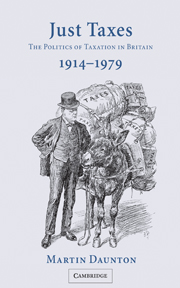Book contents
- Frontmatter
- Contents
- List of figures
- List of tables
- Preface
- List of abbreviations
- 1 The taxing state: an introduction
- 2 ‘The limits of our taxable capacity’: war finance, 1914–1918
- 3 ‘This hideous war memorial’: debt and taxation, 1918–1925
- 4 ‘Adjusting the particular turns of the different screws’: reforming the income tax, 1920–1929
- 5 ‘The great conflict of modern politics’: redistribution, depression and appeasement, 1929–1939
- 6 ‘The exigency of war’: taxation and the Second World War, 1939–1945
- 7 ‘The mortal blows of taxation’: Labour and reconstruction, 1945–1951
- 8 ‘A most injurious disincentive in our economic system’: Conservatives and taxation, 1951–1964
- 9 ‘Modern and dynamic economic policy’: Labour and taxation, 1951–1970
- 10 Rethinking taxation policy: from an opportunity state to an enterprise society, 1964–1979
- 11 ‘Highly defensible ramparts’: the politics of local taxation
- 12 Conclusion
- Appendix: chancellors of the Exchequer and prime ministers, 1908–1983
- Bibliography
- Index
9 - ‘Modern and dynamic economic policy’: Labour and taxation, 1951–1970
Published online by Cambridge University Press: 23 December 2009
- Frontmatter
- Contents
- List of figures
- List of tables
- Preface
- List of abbreviations
- 1 The taxing state: an introduction
- 2 ‘The limits of our taxable capacity’: war finance, 1914–1918
- 3 ‘This hideous war memorial’: debt and taxation, 1918–1925
- 4 ‘Adjusting the particular turns of the different screws’: reforming the income tax, 1920–1929
- 5 ‘The great conflict of modern politics’: redistribution, depression and appeasement, 1929–1939
- 6 ‘The exigency of war’: taxation and the Second World War, 1939–1945
- 7 ‘The mortal blows of taxation’: Labour and reconstruction, 1945–1951
- 8 ‘A most injurious disincentive in our economic system’: Conservatives and taxation, 1951–1964
- 9 ‘Modern and dynamic economic policy’: Labour and taxation, 1951–1970
- 10 Rethinking taxation policy: from an opportunity state to an enterprise society, 1964–1979
- 11 ‘Highly defensible ramparts’: the politics of local taxation
- 12 Conclusion
- Appendix: chancellors of the Exchequer and prime ministers, 1908–1983
- Bibliography
- Index
Summary
Many people think of the Labour Party as a ‘higher taxation’ Party … It is very important that we should establish the fact that we stand for the more equitable distribution of taxation; this means easements for some as well as heavier (but fairer) burdens for others.
LPA, Finance and Economic Policy Sub-Committee, RD139/Apr. 1961, ‘Taxation of profits and income proposals for reform’: memorandum by D. HoughtonThere was no evidence that high taxation had a disincentive effect.
George Woodcock of the TUC: MRC, TUC MSS 292/410.2/2, ‘Report of a meeting between the Economic Committee, the chancellor of the Exchequer and the minister of labour, 1 Apr. 1952’, 4 Apr. 1952By the time Labour lost power in 1951, leading civil servants felt that Labour's fiscal policy was threatening economic growth and efficiency. Although Labour politicians were less inclined to accept the need for a shift to a free market economy with incentives for higher incomes, many members of the party admitted that the tax system should be reassessed. The Attlee government established a Royal Commission on the Taxation of Profits and Income in 1951. The main lines of Labour's fiscal policy emerged from the memorandum of dissent to its report (largely the work of Nicholas Kaldor), and from a series of internal working parties. When it returned to power in 1964, Labour introduced a major series of reforms to the tax system, escaping from the constraints of the Conservative government, and adding a layer of complexity to the fiscal system.
- Type
- Chapter
- Information
- Just TaxesThe Politics of Taxation in Britain, 1914–1979, pp. 279 - 301Publisher: Cambridge University PressPrint publication year: 2002



